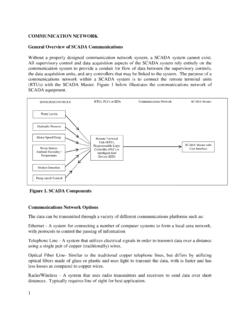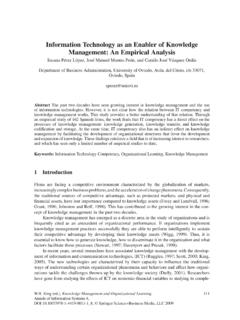Transcription of History of Mobile Telephony - University of Kentucky
1 History of Mobile Te l e p h o n y MAS 490: Theory and Practice of Mobile Applications Professor John F. Clark Everything I know about Mobile Telephony , I learned from: Evolution is not a theory when it concerns cell phones Early History of Radiophones Nicola Tesla and Guglielmo Marconi were the founders of wireless technology Ship to shore radiotelegraphy employed wireless use of Morse Code Later, radiophones and radiotelephony transmitted speech In 1900 Reginald Fessenden invented early broadcasting, transatlantic two-way voice communication, and later television Te s l a , M a r c o n i , a n d F e s s e n d e n The Great Wireless Fiasco Early History of Radiophones In 1926 radiophones connected people traveling on trains in Europe A little later, they were introduced in planes, but this was too late for World War I Radiophones made a huge difference in WWII planes, tanks, and field communication via backpack radios and walkie-talkies.
2 Later, in the 1950s, radiophones made civil and commercial services possible Military Field Communications Civil Field Communications Civil Field Communications, pt. 2 Early History of Mobile Telephony The 60s and 70s saw a variety of commercial car services the earliest weighed 90-100 pounds These services operated using high power transmissions The concept of low power transmission in hexagonal cells was introduced in 1947 The electronics were advanced enough by the 60s to pull it off, but there was no method for handoffs from one cell to the next High Power Mobile Phone Low Power Mobile Phone System Early History of Mobile Telephony That problem was solved with the first functioning cell system and first real cell phone call in 1973. The phone, which weighed about six pounds, was developed by Martin Cooper of Motorola Bell Labs and Motorola were the main competitors in the US. Bell Labs did most of the work developing the cell technology, but Motorola was ahead in phone development But they both lost out to Japan and Northern Europe.
3 Service began in Tokyo in 1979 and Nordic Mobile Telephone was founded in Norway, Sweden, Finland, and Denmark the same year Early History of Mobile Telephony Tests began in the Baltimore/DC area in 1981 The first commercial service began in 1983 with the advent of the legendary Motorola DynaTAC 8000X In 1984 Bell Labs perfected the modern system of cellular Telephony that we use today Thus began first generation analog cellular Telephony (1G), though we didn t call it that at the time Motorola DynaTAC 8000X When is a phone not a phone? Yo u r c e l l p h o n e i s n t r e a l l y a t e l e p h o n e i t s a r a d i o transceiver, or a radio telephone It s more like a full-duplex walkie-talkie with better signaling capabilities Of course, nowadays your smart phone is much more than that, as we all know But the basic principles for cellular Telephony , including the cell system, remain the same as the early 80s Generations 1G: Analog transmission using the electromagnetic spectrum in the same fashion as any two-way radio 2G.
4 Introduced in the 90s, it was characterized by digital technology and out of band signaling 2G introduced texting the first text (SMS) messages were sent in Finland in 1993 Finland was also the site of the first digital content delivered to cell phones besides texts ringtones and advertising Global System for Mobile Communications (GSM) began in Finland in 1991 GSM GSM is a globally accepted standard for digital cellular communication It s also the name of a standardization group founded in 1982 to create a common Mobile telephone standard in Europe This group was among the first to choose a digital standard over an analog standard The GSM standard was designed to establish compatibility among competing standards GSM Decisions and Milestones Working group founded in 1982 Committed to digital standard in 1985 Field tested in 1986 Chose narrowband (TDMA) system in 1987 Preoperation system set up in 1990 First commercial roll-out in 1991 Progressive coverage from cities to rural areas 1992-1995 Strictly a European phenomenon at the time Generations 3G.
5 First tested in Japan in 2001, it was definitely a Pacific Rim kind of thing The significant development was packet switching for data transmission Through the development of various new technologies, speeds kept increasing and streaming audio and video became possible By the end of 2007 there were 295 million 3G customers worldwide, which was only 9% of all subscribers Generations 4G is on the horizon The only genuine contender in the US at this time is Verizon s Long Term Evolution (LTE) Was rolled out in Lexington last fall, but you have to have the right phone Data transmission speeds may be as much as ten times faster than 3G Eliminates circuit switching for voice and treats all voice traffic as Voice over Internet Protocol (VoIP) Fun Facts Tr e m e n d o u s l y f a s t a d o p t i o n r a t e : million subscribers worldwide in 1990 Over six billion subscribers in 2012, over 480 times as many as 1990 The world's largest individual Mobile operator by subscribers is China Mobile with almost 650 million Mobile phone subscribers.
6 Korea and Japan top all other countries for Mobile broadband penetration Fun Facts Apple receives far more publicity than any other Mobile phone manufacturer, but on the world stage it is still a pretty small player percent of Mobile users don t have one mostly they use Nokia or Samsung; and even among smart phone users 84 percent don t have an iPhone 468 million cell phones were sold in 2011, a percent increase from 2010 39 percent were powered by the Android operating system A Cell Phone For Everyone










